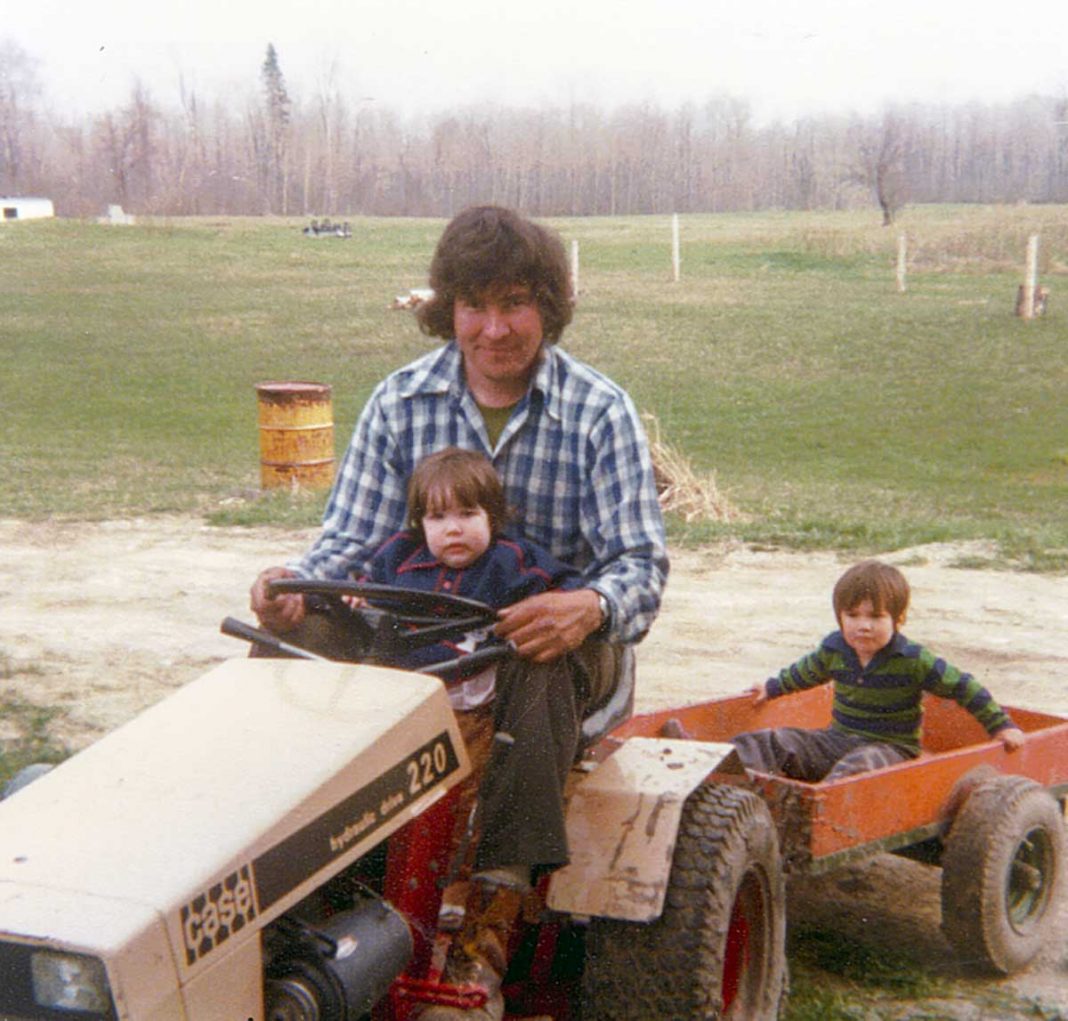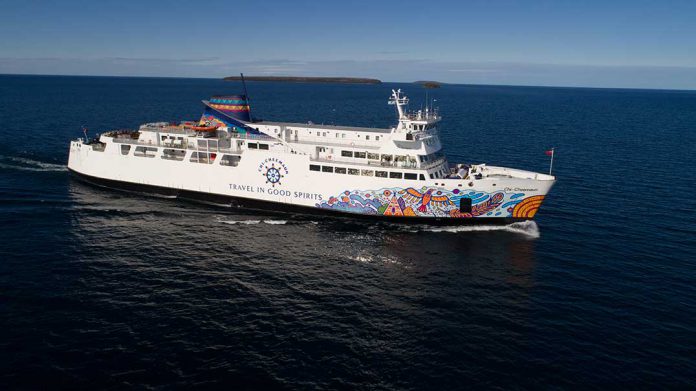Susan and Gene Bebamash
The Bebamash family has much to share. A strong love for the past is evident by their compelling stories and authentic documents, both of which have true nostalgic and historic worth. The couple lives in a picturesque part of M’Chigeeng and despite retirement, both continue to share their collective expertise with the community and various local organizations. Gene started as a fishing guide and moved into the construction field, working on the M’Chigeeng water system, the new church (when it was built after the old church burned) and the new administrative offices. Later he shared ROM (Royal Ontario Museum) history with the Anishnabek youth of Ontario. Susan loved to teach and spent her career in M’Chigeeng, inspiring young minds.
“Our history goes back eight generations,” Susan begins. “Dad’s early ancestor, John Doane, a deacon, born in 1590, came over to Plymouth Rock about three years after the Mayflower arrived. Much later, at the time of the American Revolution, my paternal ancestor Aaron and his fellow United Empire Loyalists were captured and many died. Aaron was about to be hung when his wife arrived to plead for her husband’s life. She succeeded and he was released.”
“Paternal relative Moses spied for the British. He found out that Washington was about to cross the Delaware and got a note to General Rahl who was allegedly too busy drinking and playing cards to read the note. The general was killed, and Moses had a bounty on his head after the Americans saw the note. The families relocated to Canada, to Humberstone, or Port Colbourne today. My grandfather Reginald Jessie, born in 1909, was an adult during the depression. He happened to buy a ticket for the Irish Sweepstakes and won about $40,000. He purchased an Esso gas station which still stands today in Port Colbourne.”
“Maternal ancestors came from England and Scotland in the last two generations. English great-grandfather was a railway conductor. Free family trips encouraged postcards from many American and Canadian locations. Grandfather Wesley collected these. His brothers, Harry and George, went off to war. George died of his wounds after coming home in 1920. Harry lived to a ripe old age. Wesley became a caretaker for the Pigott Office Building in Hamilton.”

“There is a photo of my dad, Reginald Edward Doane, in uniform at age 16. He had forged his mother’s signature to be enlisted in the army. He made it to Camp Borden, but fortunately his real age allowed an honorable discharge. At 17, he joined the Merchant Marines and sailed the Great Lakes. He also practised his shooting in case the German subs came closer to the shore.”
In 1945, Edward moved to Hamilton where he met and later married Isabelle McDonald. Susan was born on May 7, 1947, the same year that Edward started at Westinghouse. Sister Linda was born in 1948. When they were older, Isabelle worked for a cloth-making factory. She operated machines that cut, wove, dyed and knit fabric for big clothing manufacturers.
“I remember my sister Linda scalping me at age five. She was four. She cut off all my long hair, leaving just a thin choppy layer, so I had to go to school with a boy’s haircut. In retaliation, I succeeded in cutting off only one curl from her. Kindergarten was a challenge for me because I could not pronounce a ‘v.’ Convertible became ‘conbertible.’ After Kindergarten was over, I was put into ‘reading readiness’.”
“Most trips were to our grandparents. We spent Saturdays with the McDonalds in Hamilton, a popular spot for cousins to meet. Cousin Bruce’s band was allowed to play there. Our grandparents had all the latest vinyl records too. Sundays it was off to the Port Colbourne grandparents.”
In high school, Susan enjoyed clubs like geography, tennis and volleyball. “We lived on ‘Hamilton mountain’ just 10 minutes from school. Mum was working so it was my job to cook supper every night until I left home to attend teachers’ college in 1968.”

“After college, I applied to Indian Affairs to be in the north. Before heading out to Frobisher Bay, I got a call from Gerry Closs, the Superintendent of Education in Manitowaning. ‘Your name came across my desk in Toronto and I need a teacher for Lakeview School on Manitoulin right away.’ I took that job in 1969 and stayed 43 years.”
Susan had a medical emergency in 1970. “I couldn’t stand up. My friend Irene, a fellow teacher, took me to Little Current where Dr. Stevens operated on me very quickly and all went well. On a funny note, when Irene came to Manitoulin as a new teacher she was anticipating seeing teepees when she first crossed the bridge!”
“I was teaching Grade 5 at Lakeview when Jesse, one of my students, started to tell me all about her Uncle Gene. For the next two years, I had her brother and then her sister in my class and they continued to extoll the virtues of their uncle. I finally met Gene through my friend Ann Debassige. Gene came one snowy winter evening to give me a ride on his snowmobile. On the way he was caught in drifting snow and hit a parked car. He sustained injuries and badly damaged his snowmobile but got to my house. That was how we met.”
Gene begins, “My great-great-great grandfather was a treaty signer in Magnetawan. Great-grandfather Paimoquanishkung (Jean Baptise), born 1801, was a signer of the 1862 treaty of Manitoulin Island, and chief of Machegewondemong (M’Chigeeng). He signed his name with the symbol of a caribou. The 1850 Huron Treaty saw land parcels given by McDougall to current families in M’Chigeeng. Grandfather Frances and his wife Ann also got a tract of land here. Most lots were 50 acres in size.”
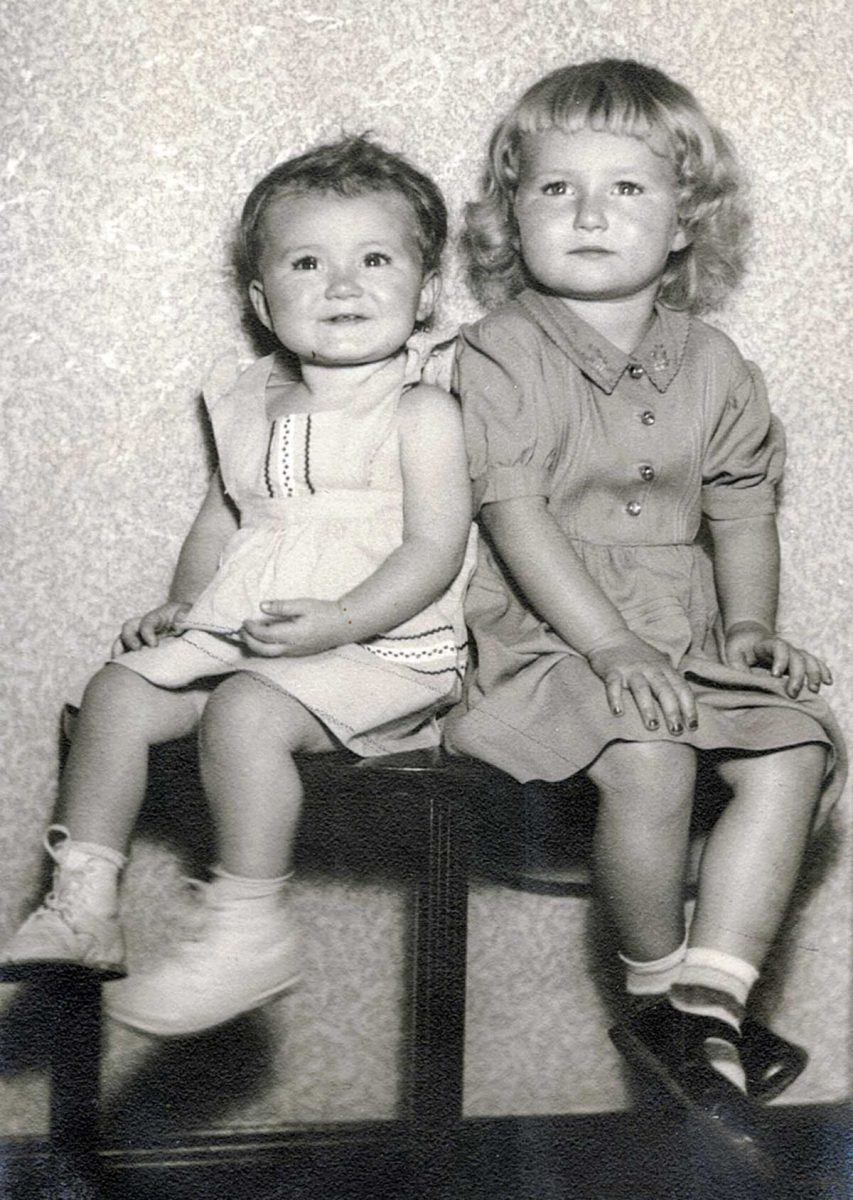
“Dad Issac farmed and later became chief of this reserve. He was invited to Ottawa in the 1950s. Gene was born on November 2, 1948 to Florence and Issac. His older siblings are Gus, Herman, Eddy, Phyllis and Loretta. Only Loretta is left, living in the Wellness Centre here. “I remember the barn, plow horses that pulled sleighs and wagons. We had cows for milk, cream and butter. Kids in the village got the extra milk and some went to the animals. Enough cream went to Wagg’s Dairy in Mindemoya to buy sugar and flour.”
“I hated our white turkeys because they would attack me. I had to wait for them to leave before I could go outside. We did eat their meat and bartered them for other items. We had a big garden, animals and lots of good food to eat. Mum would alter used clothing for us. When I was just three, she was paralyzed with a bad stroke, but she worked hard to regain her strength. We helped with all the inside chores. Dad did the outside work and collected dry wood for cooking. Extra help came from two of mum’s nieces who came to live with us. By summer, the well usually went dry, so we helped dad collect water from the lake, using the wagon.”
“At four, we rented a house in the village for two winters, so I could walk to school. Older siblings had left by then. In the summer we moved back to the farm. By the third winter I was old enough to walk from home. It took 45 minutes and sometimes I caught a ride downhill on a friend’s bike. I always had to walk back as it was too hard to peddle uphill, especially with somebody else on the cross bar.”
“Our first teacher was nice, but she didn’t understand our language. Eventually, she picked up some of our words and we began to learn English from the stories she told us. Drawing helped too. We had two rooms in the school. Grades 1 to 6 in one room (each grade in its own row) and Grades 7 and 8 in the other. We had an outhouse and a wood fire for heat. Later, the new school had inside washrooms and more space.”
“I didn’t like school. I wanted to be outside, not in a class where everything was in English and you got the strap, if you didn’t understand, from both Native and non-Native teachers. Fear froze any real learning, but I never confided this to my parents. I never got to Residential School, because I was always out of sight when the agents came. I heard kids were lonely at that residential school. They missed their family and their community. I’m glad I didn’t go.”
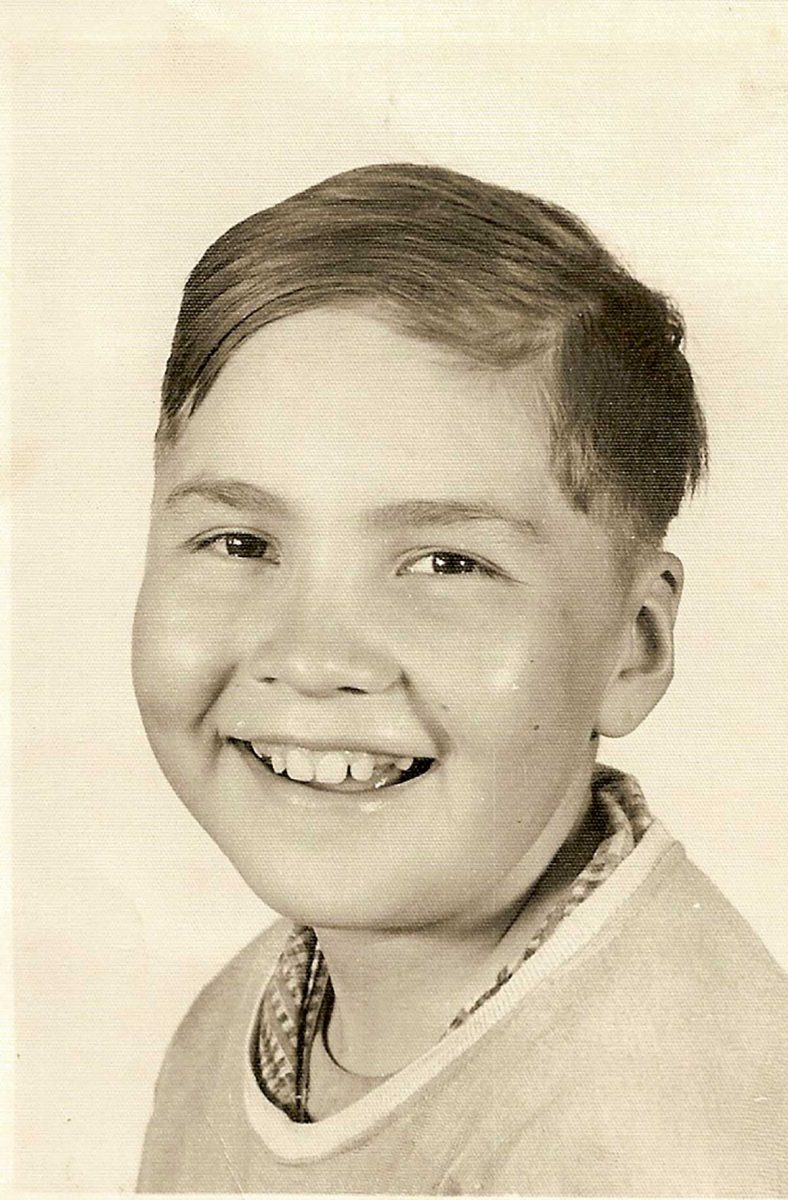
“Carmalita Fox was a good teacher in my early years, but I left as a teen, after starting Grade 7. I had fallen behind and instead of helping me, they moved me to the back of the class, so I quit school. Dad was beginning to slow down more, so we moved to the village where water came from a nearby creek. Others brought wood now too. Dad had been a perfect tree harvester, cutting a tree flush with the ground using a cross-saw. Branches would be distributed to blend in with the ground cover and fertilize the earth. All dead trees were cut down too. Sadly, dad died at age 66. Then I took over his work.”
Indian Affairs provided a small widow’s pension. “They also wanted me out of the house, earning extra income, but I was mum’s only support. The two young girls couldn’t do much of the heavy work. For two summers, my brother got me a job as a fishing guide for a lodge at Rockville owned by Brock Chisholm’s grandfather. I also fixed televisions and put up towers in Gore Bay. My first real construction job, because I had to pay unemployment insurance, was putting in a water system for our town in the 1960s. The town didn’t like the sulphur dioxide in their good drinking water. We also needed water for the school and for fire protection.”
“Lots were surveyed, and construction began for the water, using a gravity system coming from the old road to Mindemoya. It was uphill right to the lake. Indian Affairs was in charge and the first connection bringing pure lake water to the community was the town site and the school in the Lakeview area. Liquid chlorine was supposed to ensure the water was safe, but the unused canisters of chlorine began to pile up. Some surprised engineers later found the hazardous chlorine and got rid if it. The system was never quite finished, and the hole blasted into rock for a residual pond was never used either. Sewers were put in, but nobody had been hired or taught to run the system at that time.”
A home for the teachers, a teacherage, was built across Highway 551 from Lakeview School and the following year, Susan moved in as a ‘beginning’ teacher. Not long after, in 1971, the old church in M’Chigeeng blew up on a stormy, icy day. Susan had knocked on the church door earlier, to reach John Reynolds in his residence upstairs, but he hadn’t answered. A little while later, a loud explosion was heard due to leaking propane. Sadly, John died that day.
“I was at home and I heard a loud bang,” Gene recalls, “you could see snow, insulation and lumber bits flying. I jumped into the car and slid along the icy road to help. The fire had engulfed the church could hit the priest’s residence next. I stopped for George the maintenance man and the antique fire truck we got from Camp Borden. Meanwhile my car started to slide downhill and got stuck in a snowbank.” It was a difficult day.
Gene helped build the new church designed by German architect Manfred Mann. Father Mike Murray joked that, “We made it round so the devil can’t corner you.” It was finished a year later. Susan and Gene were the first couple to be married there. Their wedding took place on July 1, 1972, a beautiful sunny day. Susan’s parents, her sister and a friend attended for the bride. The theme colours were yellow and purple. “I cried when I saw how many people had packed the church,” Susan shares. “My sister-in-law did a lot of the cooking. Our reception was in the back yard.”
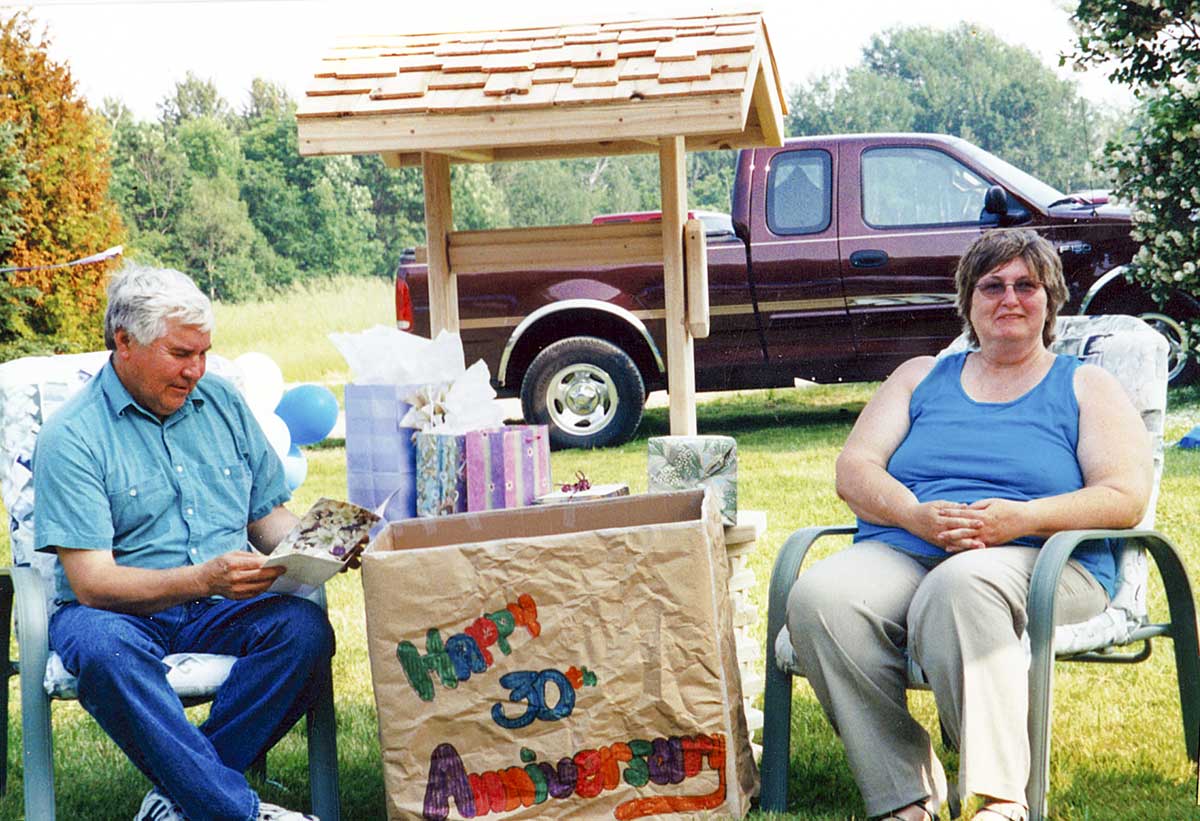
The new band administration offices were built next while the newlyweds lived in the teacherage. Their first child would not be born for four years. Gene’s next job came from Basil Johnston, working for the ROM. He would be visiting reserves with a display bus full of big movie reels made by the National Film Board. The kids loved to see these movies and the artifacts that were on the bus. However, the following year left Gene disappointed. The bus had not been updated with new movies and artifacts. The kids were sad too, saying they had seen all this.
Gene’s next work was with Mary Lou Fox for the inception of the Ojibway Cultural Foundation. He did a presentation that would show the history of M’Chigeeng and help explain the purpose of the proposed museum. All artifacts were being stored in a trailer at that time. After a lengthy fundraising campaign, the beautiful centre we now know as the OCF, was built.
After a few years of marriage, Gene began to build his own house for $12,000 using a floorplan he liked from an advertisement. He cut the trees in the bush, got them milled, got a co-signed loan from the bank for $5,000. Wilfred Taibossagai helped with the foundation. “Ontario Hydro took 12 months to put the power in and the day they came, it took no time at all. It was our responsibility to keep the line free of trees.”
“Our first child, Roger, was five months old when we moved into the house. A lot still had to be finished. Daughter Shannon was born two years later. We used to take them camping and to destinations like Niagara Falls or Marineland.” Shannon and Susan also visited North Carolina and Florida. From 1986 to 1990, Susan taught special education. She went back to teaching Grade 1 that year and then returned to Special Education in 2000. Susan sat on SEAC, a Special Educational Advisory Committee for the Board of Education for several years while teaching special education. After she retired in 2012, she tutored kids four days a week during the school year. She still tutors today.
“Favourite season? Summer when its warm,” Susan adds smiling. “For me it’s spring, summer and fall. I just love being outside,” says Gene. “We like to walk the boardwalk in Providence Bay and beside the Bridal Veil falls in Kagawong.”
Awards? We both got volunteer awards from the community. Susan got one for teaching excellence. What are our strengths? Susan is artistic, likes to ‘read people’ and teach. Gene is innovative, loves history too and likes construction. “I look at the big picture, before I try to put parts together.”
“What we would still like to do? Ride across Canada in a train.” Cruise to Alaska for Susan and powerboating for Gene. “We loved being parents and watching the kids master challenges over the years. Anything we would change if we could go back? Not with my teaching career,” Susan confirms.
Recipe for happiness? “Be patient and communicate face to face. Always thank the Creator for a good day and smudge, telling him what you are grateful for and try not to be afraid.”
The last five years have found the couple doing volunteer work. Susan and Gene have been helping at the elders’ building in town. “The elders used to share stories that included hopes for the future, but stories became rare after the phones went in,” Gene confirms. Both help with the M’Chigeeng fall harvest, showing participants how to process the corn and make corn soup.
Quilting and oil painting kept Susan interested in earlier times. These days, she still quilts. She also makes cards and does scrapbooking, doing a wonderful job of both. “My mentor was Colleen Edwards who started a scrapbooking club a few years ago. Colleen died last year, and I have had a difficult time getting back into scrapbooking again.”
Gene teaches the language on Tuesdays and Thursdays at Kenjgewin Teg in an immersion program. He has also added his own language teaching, having students make flutes in his garage and other locations, using the language throughout the process. Susan provides the food.
“We have grandchildren now, Jacob and Kaleb. Our son lives nearby. Daughter Shannon was the General Manager of the Comfort Inn in Parry Sound, now she is with the Marriott chain in the Muskokas.”
“As mentioned, we are both interested in history,” Gene adds as he brings out a map of the community with all the people who lived here in the 1950s, their houses identified and lots of paths. “No roads had been built yet.” An award for excellent teaching given to Susan is on the table. The Robinson Huron Treaty is displayed, as are the signatures of the chiefs signing the Manitoulin treaty of 1862 which includes the ‘caribou’ of Jean Baptise. The logbook of Gene’s grandfather has fragile pages bearing daily entries. They reveal his main chores were cutting and splitting wood and helping his neighbours. Births and deaths were also recorded.
“We like the laid-back pace of Manitoulin. I miss Hamilton but there is no way I would live there, Susan reflects. “We had offers to work and live elsewhere but we chose to stay here. Gene was born here.”
“This is my homeland. I love the quiet of the bush, of nature, listening to birds and watching animals,” Gene adds. “I respect the forest as my dad did. We want the history of this Island to be available for generations to come. Elders are passing on and taking much of their knowledge with them. We are doing what we can to keep the work of our forefathers alive for the future inhabitants of this Island.”

